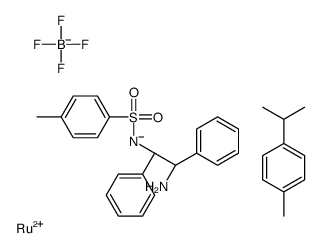1192483-03-6
| 中文名 | {[((1R,2R)-2-氨基-1,2-二苯乙基](4-甲苯磺酰基)酰胺基)(对甲基异丙基)四氟硼酸钌(II) |
|---|---|
| 英文名 | [(1R,2R)-2-amino-1,2-diphenylethyl]-(4-methylphenyl)sulfonylazanide,1-methyl-4-propan-2-ylbenzene,ruthenium(2+),tetrafluoroborate |
| 分子式 | C31H35BF4N2O2RuS |
|---|---|
| 分子量 | 687.56100 |
| 精确质量 | 688.14900 |
| PSA | 68.54000 |
| LogP | 10.69820 |
|
Section 1: Product Identification {[(1R,2R)-2-amino-1,2-diphenylethyl](4-toluenesulfonyl)amido}(p-cymene)ruthenium(II) tetrafluoroborate, min. Chemical Name: 97% CAS Registry Number:1192483-03-6 Formula:C31H35BF4N2O2RuS EINECS Number:none
Chemical Family:organometallic complex Synonym:none Section 2: Composition and Information on Ingredients IngredientCAS NumberPercentACGIH (TWA)OSHA (PEL) Title compound1192483-03-6100%2.5mg/m3 (as F)2.5mg/m3 (as F) Section 3: Hazards Identification Emergency Overview:Irritating to skin, eyes and respiratory tract. May be harmful if swallowed. Primary Routes of Exposure:Ingestion, inhalation Eye Contact:Causes slight to mild irritation of the eyes. Skin Contact:Causes slight to mild irritation of the skin. Inhalation:Irritating to the nose, mucous membranes and respiratory tract. Ingestion:No information available on the physiological effects of ingestion. May be harmful if swallowed. Acute Health Affects:Irritating to skin, eyes and respiratory tract. Chronic Health Affects:Prolonged exposure to hydrolysable fluorine compounds can cause deterioration of bone and tooth structure. NTP:No IARC:No OSHA:No SECTION 4: First Aid Measures Immediately flush the eyes with copious amounts of water for at least 10-15 minutes. A victim may need Eye Exposure: assistance in keeping their eye lids open. Get immediate medical attention. Wash the affected area with water. Remove contaminated clothes if necessary. Seek medical assistance if Skin Exposure: irritation persists. Remove the victim to fresh air. Closely monitor the victim for signs of respiratory problems, such as difficulty Inhalation: in breathing, coughing, wheezing, or pain. In such cases seek immediate medical assistance. Seek medical attention immediately. Keep the victim calm. Give the victim water (only if conscious). Induce Ingestion: vomiting only if directed by medical personnel. SECTION 5: Fire Fighting Measures Flash Point:none Autoignition Temperature:none Explosion Limits:none Extinguishing Medium:carbon dioxide, dry powder or foam If this product is involved in a fire, fire fighters should be equipped with a NIOSH approved positive pressure Special Fire Fighting Procedures: self-contained breathing apparatus and full protective clothing. Hazardous Combustion andIf involved in a fire, this material may emit irritating organic fumes. Decomposion Products: Unusual Fire or Explosion Hazards: No unusual fire or explosion hazards. SECTION 6: Accidental Release Measures Spill and Leak Procedures:Small spills can be mixed with vermiculite or sodium carbonate and swept up. SECTION 7: Handling and Storage The material will degrade on prolonged exposure to air. Store under an inert atmosphere of nitrogen or argon. Handling and Storage: Keep bottle tightly sealed and away from heat and direct sunlight. SECTION 8: Exposure Controls and Personal Protection Eye Protection:Always wear approved safety glasses when handling a chemical substance in the laboratory. Skin Protection:Wear protective clothing and gloves. Ventilation:Handle the material in an efficient fume hood. If ventilation is not available a respirator should be worn. The use of respirators requires a Respirator Respirator: Protection Program to be in compliance with 29 CFR 1910.134. Ventilation:Handle the material in an efficient fume hood. Additional Protection:No additional protection required. SECTION 9: Physical and Chemical Properties Color and Form:brown-purple solid Molecular Weight:687.6 Melting Point:no data Boiling Point:no data Vapor Pressure:no data Specific Gravity:no data Odor:none Solubility in Water:Insoluble SECTION 10: Stability and Reactivity Stability:air sensitive Hazardous Polymerization:no hazardous polymerization Conditions to Avoid:prolonged exposure to air Incompatibility:oxidizing agents, halogens carbon monoxide, phosphorus, nitrogen and boron oxides, organic and fluorinated fumes, and ruthenium salts Decomposition Products: SECTION 11: Toxicological Information RTECS Data:No information available in the RTECS files. Carcinogenic Effects:No data Mutagenic Effects:No data Tetratogenic Effects:No data SECTION 12: Ecological Information Ecological Information:No information available SECTION 13: Disposal Considerations Disposal:Dispose of according to local, state and federal regulations. SECTION 14: Transportation Shipping Name (CFR):Non-hazardous Hazard Class (CFR):NA Additional Hazard Class (CFR):NA Packaging Group (CFR):NA UN ID Number (CFR):NA Shipping Name (IATA):Non-hazardous Hazard Class (IATA):NA Additional Hazard Class (IATA):NA Packaging Group (IATA):NA UN ID Number (IATA):NA SECTION 15: Regulatory Information TSCA:Not listed in the TSCA inventory SARA (Title 313):Not reportable under SARA 313. Second Ingredient:none SECTION 16 - ADDITIONAL INFORMATION N/A |


